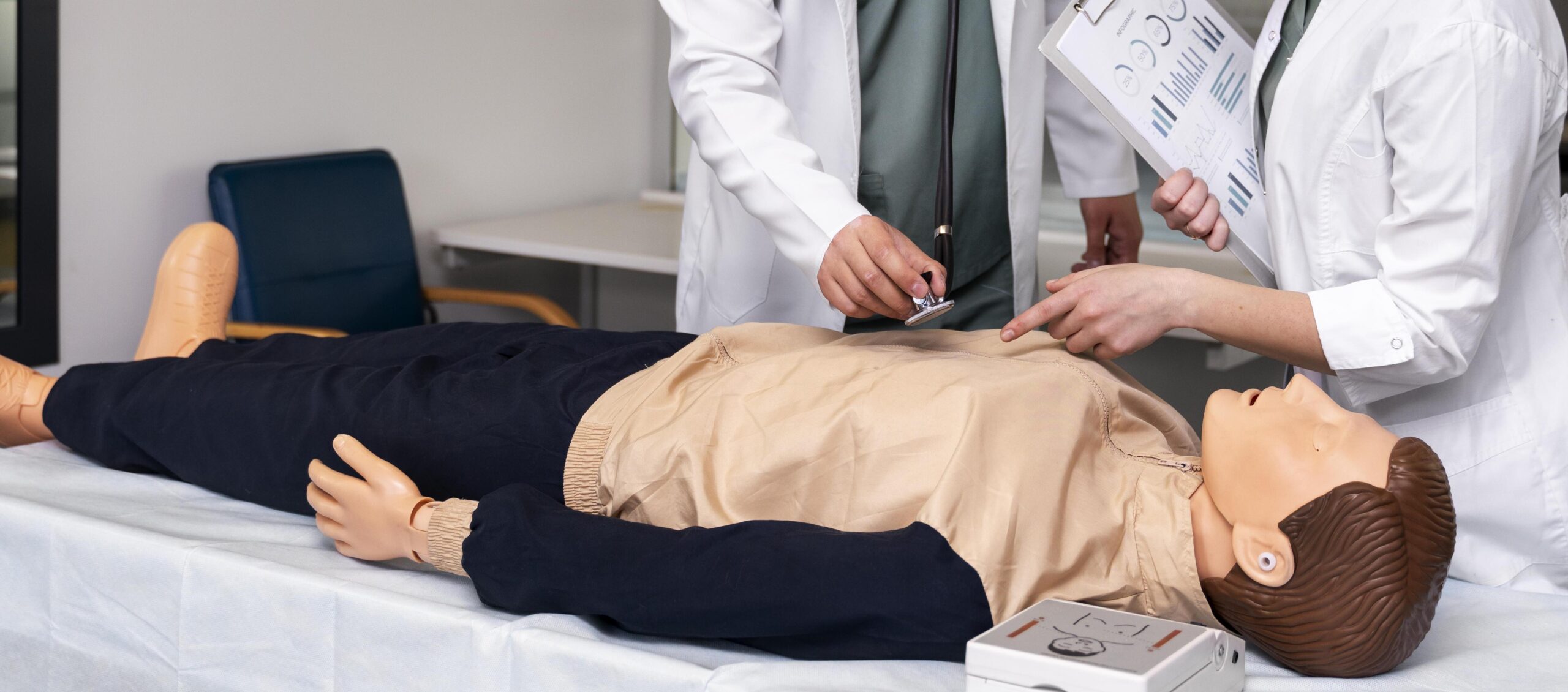When someone suddenly collapses in front of you, the difference between life and death may be your ability to respond quickly. CPR (Cardiopulmonary Resuscitation) is the critical skill that bridges the gap between sudden cardiac arrest and professional medical aid.
Early CPR can double or even triple a person’s survival chances. Yet, about 70% of cardiac arrests occur at home, which means ordinary people, not doctors, are often the first responders. This guide will explain how to perform CPR step by step, in order to prepare you to act with confidence.
What Is CPR and Why Is It Important?
CPR (Cardiopulmonary Resuscitation) is an emergency lifesaving technique used when someone’s heart stops beating or they stop breathing normally.
- Purpose: CPR circulates oxygenated blood to vital organs (especially the brain and heart) until advanced measures like defibrillation restore normal rhythm.
- Survival statistics: Immediate CPR in witnessed cardiac arrests increases survival rates to 30–40%, compared to less than 10% survival without CPR.
- Time sensitivity: Brain cells start dying within 4–6 minutes without oxygen, which makes bystander intervention vital.
- Chain of Survival: Early recognition → Early CPR → Early defibrillation → Advanced medical care.
In short, knowing how to conduct CPR equips you to become the lifeline during sudden cardiac arrest.
Steps for Performing CPR
The modern CPR sequence follows CAB (Compressions → Airway → Breathing) instead of the older ABC model. This ensures blood circulation starts as quickly as possible.
Here’s how to perform CPR step by step:
- Check responsiveness (tap and shout).
- Call for help and activate emergency services.
- Start chest compressions immediately (30 compressions).
- Give rescue breaths (2 breaths).
- Continue cycles of 30:2 until professional help arrives.
- Use an AED (Automated External Defibrillator) as soon as it becomes available.
Checking Responsiveness: The First Critical Step
Before starting CPR, it’s essential to confirm that the person truly needs it. Performing CPR on someone who is conscious or breathing normally can cause harm.
- Approach safely: Make sure the area is free of danger (traffic, fire, electrical hazards) before reaching the person.
- Tap and shout: Firmly tap the person’s shoulder and call out loudly: “Are you okay?”
- Look for breathing signs: Observe the chest for 5–10 seconds. Normal breathing is steady and rhythmic; agonal gasps (snorting or irregular gasps) are not normal and count as no breathing.
- Decide quickly: If unresponsive and not breathing normally, do not delay — begin CPR immediately.
Solution clarity: This is where confusion arises. Basic Life Support (BLS) covers the wider set of emergency interventions (airway, AED use, recovery position), while CPR is the specific resuscitation technique within that framework. Confirm between BLS vs CPR which is the suitable method to go for.
Calling for Help: Activating the Emergency Chain of Survival
Early activation of emergency services ensures professional help is already on the way while you start CPR.
- Call emergency services: Dial 108 (India) or the local emergency number immediately.
- Give essential details: State your exact location, describe the patient’s condition (unconscious, not breathing), and provide age/gender if possible. This helps responders prepare the right equipment.
- Stay on the line: Follow the dispatcher’s instructions. Many regions now provide dispatcher-assisted CPR, guiding you through chest compressions in real time.
- Prioritize AED retrieval: If someone can bring an Automated External Defibrillator (AED), instruct them. Early defibrillation is often the single most important survival factor in cardiac arrest.
Chest Compressions: The Core of Effective CPR
High-quality compressions are the heart of CPR. They keep oxygenated blood flowing to the brain and other organs until professional treatment arrives.
- Hand placement: Put the heel of one hand on the center of the chest (lower half of the sternum). Place your other hand on top and interlock fingers.
- Body position: Lock elbows, keep shoulders directly over hands, and use your body weight to compress effectively.
- Compression depth and rate: Push hard and fast, 5–6 cm (2 inches) deep, at 100–120 compressions per minute.
- Allow chest recoil: After each push, release completely to let the chest rise — this refill of blood is crucial.
- Avoid mistakes: Don’t bounce, lean, or pause unnecessarily; these reduce CPR effectiveness.
Rescue Breaths: Restoring Oxygen Supply
Chest compressions circulate blood, but rescue breaths provide the oxygen that blood needs to deliver.
- Airway management: Tilt the head back and lift the chin to open the airway.
- Seal and breathe: Pinch the nose shut, cover their mouth with yours, and give a steady 1-second breath. Watch for chest rise, this confirms effective ventilation.
- Breath ratio: After 30 compressions, deliver 2 breaths before returning to compressions.
- Barrier devices: If available, use a CPR mask or face shield to reduce infection risk.
- Special consideration for infants/children: Use only gentle “puff” breaths; small lungs require far less air. Too much pressure can cause injury.
Continuing Until Professional Aid Arrives: Persistence Saves Lives
Once CPR begins, consistency is key. Stopping prematurely can drastically lower survival chances.
- Maintain cycles: Keep repeating 30 compressions: 2 breaths continuously.
- Do not stop unless:
- The person shows signs of life (breathing, movement, coughing).
- A trained responder or medical team takes over.
- You are too exhausted to continue.
- AED integration: If an AED arrives, turn it on immediately and follow the voice instructions. This may involve pausing compressions briefly while the device analyzes the heart rhythm.
- Golden rule: Call – Push – Shock. Early defibrillation plus high-quality CPR offers the best chance of survival.
Signs That Indicate You Should Perform CPR: When Seconds Matter
One of the hardest decisions in an emergency is knowing when to start CPR. Delaying can be fatal, while beginning too soon is rarely harmful. Recognizing the signs quickly allows you to act without hesitation.
- Unresponsiveness: If the person does not respond to tapping or loud shouting, treat it as a red flag. Shaking their shoulders gently and calling their name (if known) is a quick test.
- No breathing or abnormal breathing: Check for chest movement, listen for air, and feel for breath on your cheek for 5–10 seconds. If they are not breathing or only gasping irregularly (agonal gasps), assume cardiac arrest.
- Sudden collapse: A person who suddenly falls without warning, especially if followed by silence and stillness, is likely experiencing sudden cardiac arrest.
- Pulselessness: For trained professionals, the absence of a pulse confirms cardiac arrest. However, pulse checks are not recommended for lay rescuers because they take time and are often inaccurate under stress.
In all these cases, waiting for EMS wastes precious minutes. It’s time to act immediately with the correct CPR method .
Common Mistakes to Avoid When Performing CPR: Protecting Quality and Effectiveness
Even with the best intentions, many people unknowingly reduce CPR effectiveness. High-quality CPR is about consistency, technique, and avoiding errors. Here’s what to watch out for:
- Incorrect hand placement: Hands positioned too high can damage the ribs, while too low risks injuring internal organs. The correct spot is the center of the chest, on the lower half of the sternum.
- Shallow compressions: Compressing less than 5 cm (2 inches) in adults won’t circulate enough blood. Fatigue is a common reason for shallow compressions.
- Poor compression rate: Going too slow reduces circulation, while going too fast doesn’t allow the chest to recoil fully. Aim for 100–120 compressions per minute.
- Overventilation: Blowing too much air or too forcefully can push air into the stomach, causing vomiting and complications. Keep breaths gentle and just long enough for chest rise.
- Unnecessary interruptions: Stopping compressions frequently to “check for a pulse” or to rest breaks the flow of oxygenated blood. Minimize pauses to less than 10 seconds.
- Leaning on the chest: Failing to let the chest fully rise prevents proper refilling of the heart between compressions.
To dive deeper into avoiding these pitfalls and strengthening your first-aid skills, you can check resources like the Ambulance & Healthcare Blog, which shares professional guidance on life-saving practices.
How to Conduct CPR on Adults, Children and Babies: Age-Specific Techniques
CPR isn’t the same for everyone. The body size, airway structure, and oxygen needs of adults, children, and infants differ. Knowing how to adapt your approach ensures safety and effectiveness.
Adults
- Hand placement: Place the heel of one hand on the chest center, with your other hand on top.
- Compression depth: Push down 5–6 cm (about 2 inches).
- Compression-to-breath ratio: 30 compressions followed by 2 breaths.
- Key point: Use full body weight and lock your elbows to maintain consistent force.
Children (1–12 years)
- Hand placement: Use one hand for small children; for larger children, use two hands like in adults.
- Compression depth: About 5 cm (or one-third of chest diameter).
- Breathing: Provide gentle rescue breaths, just enough for chest rise.
- Key point: Children often experience respiratory-related cardiac arrest. Rescue breaths are particularly important.
Infants (<1 year)
- Hand placement: Use two fingers (index and middle) just below the nipple line.
- Compression depth: About 4 cm (1.5 inches) or one-third of chest diameter.
- Breathing: Cover the infant’s mouth and nose with your mouth, delivering gentle puffs of air.
- Key point: Infants are fragile. Use controlled, soft breaths and careful compressions.
For all age groups, early emergency services activation is crucial, and CPR should continue until help arrives. Enrolling in emergency medical training courses ensures you can confidently adapt techniques for each age group in real-life scenarios.
Emergency Response Tips: What to Do Before, During, and After CPR
Performing CPR is not just about compressions and breaths. Managing the environment, coordinating help, and following through afterward can make the difference between chaos and a controlled response.
Before CPR: Prepare the Scene
- Ensure safety: Clear the area of hazards like traffic, fire, or electrical wires before approaching.
- Use protective equipment: Gloves, masks, or a CPR face shield (if available) reduce infection risk.
- Call for help: Immediately activate EMS or assign a bystander to do so.
During CPR: Focus on Quality and Teamwork
- High-quality compressions: Push hard, push fast, and allow chest recoil with minimal pauses.
- AED use: Apply an Automated External Defibrillator as soon as it arrives. Follow the prompts without hesitation.
- Team effort: If others are present, rotate compressors every 2 minutes to reduce fatigue. Fatigue quickly lowers compression depth.
After CPR: Monitor and Support
- Recovery position: If the patient regains breathing, roll them onto their side to keep the airway clear.
- Continuous monitoring: Watch for changes in breathing, movement, or consciousness until EMS arrives.
- Handover: Share all observations (collapse time, actions taken, use of AED) with paramedics.
Modern integrated platforms, like a Red health enterprise solution , improve coordination by linking workplaces, ambulances, and hospitals for faster, smoother emergency care.
Conclusion: Be the Lifeline When It Counts
CPR is a bridge between life and death. When cardiac arrest strikes, every second matters. By knowing how to perform CPR step by step, you can move from panic to purpose.
This guide walked you through:
- Recognizing signs that call for CPR.
- Avoiding common mistakes.
- Applying age-specific techniques for adults, children, and infants.
- Managing the scene before, during, and after CPR.
But reading is only the first step. For real confidence, consider enrolling in Basic Life Support (BLS) training, where hands-on practice turns knowledge into instinct. Remember this: your calm action, steady compressions, and timely breaths may one day be the reason someone survives. The next time someone asks, ‘Does anyone know how to give CPR to a person?’ you won’t just know the answer. You’ll be ready to do it. Additionally, specialised courses for allied health professionals provide essential training to sharpen life-saving skills and ensure readiness in emergencies.




